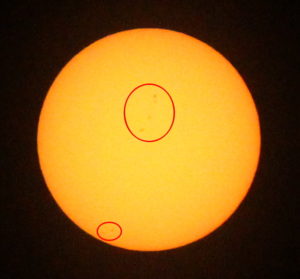The Great American Solar Eclipse
 On Meran’s birthday, we got to see a total eclipse. The day before, we drove about 7 hours south and camped at Mud Lake (near Idaho Falls). When we arrived, we were surprised by how few people were there as the place we picked was very close to the ideal place to be for the best viewing spot. I expected many more people to arrive the night before the eclipse. We found a spot right near the lake and prepared our dinner while watching a beautiful sunset. Then we went for a short walk as the sun went down. When it did, the bugs came out. We quickly decided to move our spot away from the lake, but it was dark… We knew roughly where we wanted to go so we followed Google Maps along a “road” headed in that direction. That “road” wasn’t really a road as much as an overgrown 4 wheeling trail. Luckily Meran’s car was able to make it.
On Meran’s birthday, we got to see a total eclipse. The day before, we drove about 7 hours south and camped at Mud Lake (near Idaho Falls). When we arrived, we were surprised by how few people were there as the place we picked was very close to the ideal place to be for the best viewing spot. I expected many more people to arrive the night before the eclipse. We found a spot right near the lake and prepared our dinner while watching a beautiful sunset. Then we went for a short walk as the sun went down. When it did, the bugs came out. We quickly decided to move our spot away from the lake, but it was dark… We knew roughly where we wanted to go so we followed Google Maps along a “road” headed in that direction. That “road” wasn’t really a road as much as an overgrown 4 wheeling trail. Luckily Meran’s car was able to make it. The next morning I made breakfast and setup our camera equipment. I had tested our my homemade solar filters (a pringles can, a sheet of mylar film and duct tape) previously but hadn’t actually taken pictures. I was rather impressed with the results I was getting. I was able to capture sunspots as seen in the picture. Soon after breakfast we saw C1.
- C1 is when the moon first starts going in front of the sun.
- C2 is when the moon completely covers the sun and the start of the total eclipse.
- C3 is when the sun just comes out from behind the moon and ends the total eclipse
- C4 is when the moon no longer covers the sun.
The majority of the time between C1 and C2 (a little over an hour) you can’t tell that anything is different unless you have your solar glasses on and are looking at the sun. Everything still is quite bright and seems like any other day. Only about 10-15 minutes before C2 does it start to get noticeably darker. As soon as C2 happened, it got dark. The amount of light seemed as though it was an hour or so after sunset and all around us the horizon was the same colors of after the sun goes down. And the sun… we could look directly at it without eye protection and could see the glow of the corona. In my pictures, I was able to capture solar flares as seen in this picture. The almost 2 minutes of the total eclipse was by far the most weird and worth while experiences that I have had. I got the “diamond ring” photo when the sun just peaked out at C3.




